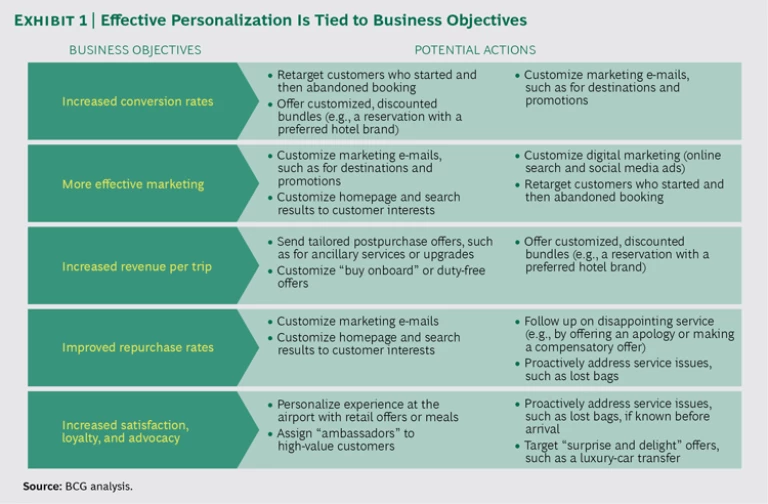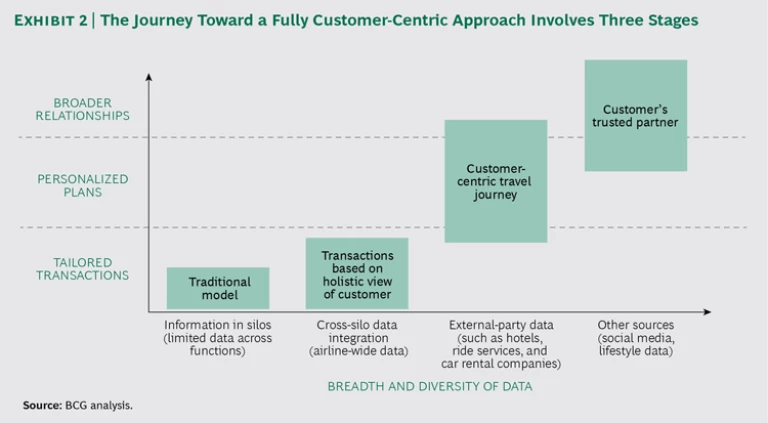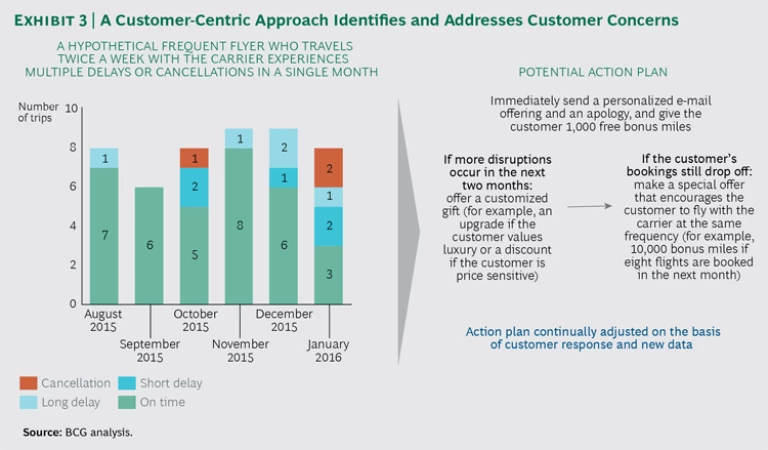Airlines need to get personal with their customers.
Thanks to digital innovators such as Amazon and Netflix—not to mention travel industry disruptors such as Uber and Airbnb—consumers’ expectations are on the rise. If other companies can offer a customized experience, why can’t a hotel or an airline? The numbers tell the story. In one recent survey, more than 85% of travel consumers said they value personalization. In another, more than 85% said personalization has affected their travel purchase decisions.
As we wrote earlier this year, personalization is a powerful tool for travel companies looking to protect their place in the value chain. (See Travel Innovated: Who Will Own the Customer? , BCG Focus, January 2016.) With the wealth of consumer data at their disposal (both their own and from other sources), airlines have an enormous opportunity to increase revenue by building strong customer loyalty rooted in a personalized experience. In fact, personalization is the most concrete way for airlines to build a consumer advantage that leads directly to value creation in the form of price premiums, cross-selling, and brand loyalty and advocacy. But there is a risk here as well: if airlines fail to act, deep-pocketed tech giants—which have already established strong footholds in travel—or well-funded startups may do so instead.
The Power of Personalization
One specialty retailer wanted to both predict and trigger changes in its customers’ behavior. It also wanted to enhance its loyalty program through individualized treatment of members. The company analyzed billions of transactions with several million customers and plotted the behavior of individual customers over time. Using data from external sources as well as its own, the retailer was able to identify categories of purchase behavior tied to life events (such as a marriage or home purchase), preferences (such as how the customer likes to be contacted), and patterns of activity suggesting that a particular action would be beneficial to the company (such as offering the customer a discount). The company then developed a set of actions, specific to each customer, intended to achieve such objectives as preventing defection or encouraging purchase in a new product category. Finally, it delivered tailored promotions and offers timed to have the greatest possible impact given each customer’s behavior or needs. Early results are promising: in certain target segments, for example, tests have shown an 80% increase in spending per capita by customers who received the personalized treatment.
Digital technologies have increased the quantity and quality of available data, vastly expanded computers’ analytical capabilities, and created new channels for engaging consumers. Combined, these advances enable an unprecedented degree of customer personalization. But the real power of personalization lies in its application to specific business objectives. Put another way, personalization furthers business objectives by relating them to an individual customer’s needs. (See Exhibit 1.) So, for example, if an airline is not as reliable as its competitors and the company is worried about the impact on its frequent flyers, an effective personalization capability might allow it to identify which customers pose the highest risk of defection because of delays and cancellations, and to then reach out with individually tailored offers designed to maintain their loyalty.
A few leading airlines are already pursuing personalization strategies. One global carrier is seeking to improve its marketing effectiveness by using data from its frequent-flyer program, website, mobile app, and partners (hotels and car rental companies, for example), and from reactions to e-mail campaigns, to better understand its customers’ behavior, needs, and preferences. This initiative has already led to tens of millions of dollars in incremental revenue, which is expected to grow further as the company expands the program’s reach and depth.
Moving Toward a Customer-Centric Approach
In the traditional airline model, different functions use different IT systems, and each function focuses on a specific set of relevant customer (or other) data. As a result, web behavior data, frequent-flyer program information, booking and travel data, and data from sources such as social media reside in silos and is not shared across functions. This limits the data’s usefulness and the company’s ability to develop “microstrategies” for individual customers. In these circumstances, change requires a company-wide effort. Moving to a fully customer-centric approach requires a journey of three stages: developing tailored transactions, designing personalized plans, and establishing broader and deeper customer relationships that go beyond personalized treatment. (See Exhibit 2.)
In our experience, some airlines are put off by the size and extent of the challenge; they mistakenly believe that the first step of the journey is a massive IT renovation project. Others try to do too much at once, with the result that their Herculean efforts are often obsolete by the time they’re completed. In reality, of all the capabilities needed to deliver a personalized customer experience, only the internal data infrastructure—with data sets from the different parts of the company combined to form complete customer profiles—needs to be well advanced in order for the first personalization initiatives to begin. As long as the future requirements of other capabilities, such as “signals” (insightful raw or processed data) and analytics, are taken into account, the journey can proceed one step at a time, with a track record of results that will help fund the journey and build enthusiasm for further steps.
Tailored Transactions. The first prerequisite is to understand each customer’s needs, wants, and experiences with the airline, which means developing complete customer profiles using data from across business units or data silos (and also potentially from partner companies). Internal data needs to be quite specific. For example, understanding the customer experience requires data on issues such as late arrivals, missed connections, turbulent flights, upgrades awarded or denied, and service mishaps. Building such a profile can frequently involve “inferring” missing data points by drawing parallels with other, similar customers for whom the company has more comprehensive data.
Acting on this information requires the ability to personalize interactions throughout the customer journey. Examples include providing customers with personalized information or offers on their own homepages; delivering tailored messages with check-in, gate, flight, and pertinent lounge information (or perhaps a coffee shop coupon) to customers’ smartphones when they arrive at the airport; or arming flight attendants with tablets that access passenger profiles to enable personalized interaction onboard.
One European airline used big data and advanced analytics to boost revenue and load factors by tailoring its e-mail offers to known or projected destination preferences. The model identified the most relevant destinations for individual customers from a basket of offers and the highest-potential target group of customers for a specific offer. Another model prioritized target customers according to their likelihood of purchasing travel to the destination offered. Both showed significant success in terms of either increased revenue or campaign efficiency.
As powerful as these types of tailored interactions can be, they do not capture the full value of personalization. They are transactional, involving one interaction at a time. They are either reactive—responding to an action by the customer, such as visiting the company’s website or taking a flight—or they focus on improving the incremental success of a mass action, such as a campaign of e-mails to the customer base in a particular region. Such campaigns can be difficult to coordinate, and duplicative or inconsistent outreach can annoy customers or cause “e-mail fatigue.” More far-reaching personalization requires a truly end-to-end customer-centric approach and action plan.
Personalized Plans. An end-to-end customer-centric approach means asking an entirely different set of questions about the role the airline plays today in meeting the needs of each customer and the additional roles it could play in the future. Say a regular customer of airline X also frequently travels on competitor carriers (which airline X knows because the traveler books trips without a return ticket or rents cars from rental partners at airports to which the airline does not fly). How can airline X gain a larger share of this customer’s flights? Or suppose the customer flies airline X regularly for business but not for leisure (which the airline knows from analysis of its own frequent-flyer data and its hotel partners’ frequent-stay data). How can the airline gain a larger share of this customer’s leisure flights? Or what if a frequent business flyer has recently experienced more delays and cancellations than usual? How can the airline show its concern and desire to make amends for the inconvenience? (See Exhibit 3.)
In order to identify the right goals and the right actions to take, airlines must gain an in-depth understanding of each customer, including the following factors:
- Share of Wallet. Airlines can determine their share of a customer’s wallet by combining booking and frequent-flyer data with other sources of data to infer trips with competitors.
- Loyalty. Does the customer fly the airline even on routes for which it can offer relatively few flights? Or does he or she choose another carrier?
- Other Traits. Is he or she an advance planner or a spontaneous traveler? Price sensitive or a big spender? With Spartan or luxurious tastes? Such profiles can be developed on the basis of multiple data sources (such as on-board purchases, hotel bookings, and booking patterns) and then used to tailor outreach and offers. For instance, an airline could offer a pass to its airport lounge to a luxury-driven customer, a frequent-flyer status upgrade to a customer who also flies with a key competitor, or a discount on an upcoming trip to a price-sensitive customer.
In a customer-centric approach, the airline sets goals for each customer that inform a “curriculum” of actions that can be implemented and measured over time. The plan is then continually refreshed and updated with new data about the customer’s behavior.
Airlines also need to think beyond their own segment of the travel industry. They have multiple opportunities to work with other companies to personalize service across the customer’s travel experience. If a flight is delayed, for example, can the airline communicate with the customer’s hotel and ride service (such as Uber or Lyft) so that appropriate arrangements can be made ahead of time? Setting up such arrangements and partnerships can be complicated because of the need to share customer data across organizations, but if travel companies don’t take the lead, third-party tech companies will be quick to spot a role they can easily fill.
Broader Relationships. The knowledge and capabilities enabled by the consumer-centric approach create the potential to build broader customer relationships through ongoing interactions. Such relationships, in turn, can create business opportunities. For example, an advanced understanding of customers can lead to better business decisions in such areas as network planning (for example, by analyzing the impact of schedule changes on high-value customers); better operational decisions (such as by basing decisions about which flights to cancel in bad weather on the profitability value of the customers onboard); and enhanced loyalty programs (by adjusting benefits on the basis of their value to individual customers).
In-depth knowledge of customers’ needs and behavior can also open up avenues for collaboration and innovation. In Asia-Pacific, Qantas has teamed up with NIB health funds, a leading Australian health insurer, on an innovative program that targets the airline’s 11 million frequent flyers and awards points to those who demonstrate healthy behaviors. Among other features, Qantas Assure encourages members to earn frequent-flyer points according to the distance they walk each day, with the data recorded by smartphones or wearable fitness tracker devices. Members can combine these points with points earned from flights, credit cards, daily grocery shopping, and mobile phone bills.
Building the Necessary Capabilities
To fund the personalization journey, build momentum, and expedite learning along the way, airlines will need to develop or acquire capabilities in three main areas.
Data Collection and Partnerships. Partnerships with other travel companies and with tech companies, such as social media platforms, will be key to acquiring the full set of data needed to understand customers’ preferences, behaviors, and other traits. Such partnerships can be either bilateral or multilateral (an example of the latter is Dihedral, recently launched by BCG and several US-based airlines and hotel companies).
Data Structuring and Integration. Personalization is not just about bigger datasets; it requires different technologies and robust data governance, including oversight of data flow, structure, access, and quality. Collecting data across sources and structuring, integrating, and analyzing it require technical skills and digital business experience. Most airlines will need to acquire such talent.
Big Data Analysis. Unlocking value using advanced analytics also requires new skills and computing capabilities, which means finding the right balance between data scientists and airline experts. Integrating these skills involves organizational decisions, such as whether to establish a centralized analytics unit or install data scientists in the business units. A third option is to set up a “federal” system, in which business units have their own teams that focus on their individual topics of interest, while a centralized team is responsible for standards setting, data and analytics governance, coordination among teams, and leadership of projects that cross business units. Most best-in-class players in other industries are moving toward centralized analytics teams to ensure end-to-end ownership and better coordination.
Company Culture and Customer Buy-In
As they acquire these new capabilities and pilot personalization initiatives, airlines will need to navigate at least two tricky courses. One is cultural; the other relates to privacy and data security.
Experts with digital and analytical skills are likely to have grown up in an environment very different from that of the typical airline head office. Integrating these experts into the organization can be challenging. The following are some pitfalls to avoid:
- An unclear or understaffed organization structure, with no formal role for the personalization team or a limited number of dedicated analytical resources
- Business processes that are not formalized (with unclear delineation of responsibilities, for example) or are inefficient (perhaps because of cumbersome interactions among business units)
- No clear reporting lines or performance objectives and metrics
- No roadmap for how to scale up successful pilots to capture their full benefits
In addition, a test-and-learn culture, which promotes a willingness to innovate, experiment, and—crucially—fail, is a key enabler but not a widespread attribute in the airline industry today. With digital channels and tools constantly emerging, airlines, like companies in other industries adjusting to the digital world, will need to become more agile, iterating much more quickly to adapt to rapidly changing conditions. This is especially true in cutting-edge areas such as personalization.
Another risk is relying too much on the power of technology. Machines can enhance the personal touch; they should not replace it. Further, there is a risk that employees will feel disenfranchised if customers have access to information—special offers, for example—that employees do not. Employees on the ground and in the air will continue to play a vital role in customer service, and any successful personalization program needs to take this role into account. Giving employees access to the right data at the right time empowers them to help customers and do their jobs better.
Airlines will also have to deal with privacy and data security, a hot-button issue in the EU—where the European Parliament recently enacted new data protection rules—and elsewhere. Customers’ privacy concerns are paramount; customers must see the benefit of giving up their personal information and know that the data is secure. If they see a clear benefit from an enhanced relationship, they will be more willing to share information. The burden will be on the airline to take a careful and progressive approach, to show tangible benefits early (and avoid any gaffes), and to make sure that the value customers see outweighs any possible concerns about the amount and sensitivity of the collected data. This is a difficult balance to strike, especially for international carriers, because customer attitudes toward privacy and security (not to mention local laws and regulations) vary significantly among jurisdictions.
Personalization and customer centricity are in their early days in the airline industry. But it is worth remembering that consumers in sectors disrupted by digital innovation have shown a pattern of exploring widely and then settling down, a phenomenon that digital innovators such as Amazon, Netflix, and Uber understand very well. Airlines that start experimenting now with getting more personal, and then move up the personalization curve quickly toward true customer-centricity, have a chance to get close to customers and cement long-term relationships while their competitors are still figuring out who their friends are.













